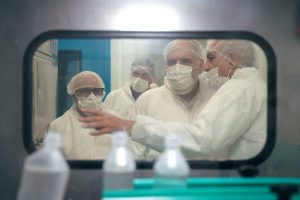
Cancer Biomarkers: Revolutionizing Detection & Treatment in Iran
Barekat Health & Pharmaceutical Group: Cancer, as a major disease posing a serious threat to global health, claims the lives of millions worldwide each year. In Iran, the incidence of cancer has been steadily increasing, making it one of the leading causes of death. Scientific and medical advancements in cancer detection and treatment over the past two decades have led to significant improvements in disease management. One of these key advancements is the use of biomarkers for prediction, early diagnosis, and monitoring treatment responses.
Biomarkers are biological molecules or indicators that can reflect the presence or progression of a disease, particularly cancer. Recently, genetic and proteomic biomarkers have been extensively studied and have played a crucial role in enhancing therapeutic methods and managing cancer patients. These biomarkers assist physicians not only in diagnosing cancer at early stages but also in determining the most personalized treatment strategy for each patient.
Biomarkers:
Definition and Introduction: Biomarkers are biological indicators that reflect biological changes associated with disease progression or responses to treatments. They can be obtained from biological samples such as blood, urine, cancer tissues, or even saliva. Biomarkers are categorized into various types, including:
– Diagnostic Biomarkers: Indicators that aid in the early diagnosis of cancer.
– Prognostic Biomarkers: Indicators that provide information about disease progression or the likelihood of recurrence after treatment.
– Predictive Biomarkers: Indicators that can forecast a patient’s response to a specific treatment.
Genetic Biomarkers:
Genetic biomarkers are identified based on genetic or epigenetic changes in cells. These may include gene mutations, changes in gene copy numbers, or alterations in DNA sequences. In cancer, genetic changes lead to uncontrolled cell growth, and genetic biomarkers can help identify these changes.
For example, mutations in BRCA1 and BRCA2 genes are widely associated with an increased risk of breast and ovarian cancers. In Iran, screening programs have been implemented to identify mutations in these genes among high-risk women. Similarly, mutations in the EGFR gene are common in patients with non-small cell lung cancer and are specifically used as predictors of response to targeted therapies.
Proteomic Biomarkers:
Proteomic biomarkers are identified based on changes in proteins expressed in cells. Proteins, as primary functional molecules in cells, play a critical role in biological processes, and changes in their levels or functions can be indicative of disease.
For example, the CA-125 protein is used as a biomarker for ovarian cancer. Elevated levels of CA-125 can indicate the presence of a tumor or disease progression. Additionally, the Prostate-Specific Antigen (PSA) protein is used as a biomarker for prostate cancer, and its levels can aid in monitoring treatment responses.
Role of Biomarkers in Cancer Diagnosis and Treatment
Iran faces high rates of various cancers, particularly gastrointestinal, breast, and lung cancers. Treatment of these diseases requires personalized approaches due to the genetic diversity of the Iranian population. Biomarkers serve as key tools to enhance diagnostic accuracy and improve responses to available treatments. With increased access to advanced genetic and sequencing technologies in Iran, the use of genetic biomarkers has significantly risen. These biomarkers are used to identify specific gene mutations that may increase cancer risk or influence a patient’s response to targeted therapies.
For instance, the use of genetic biomarkers such as BRCA1 and BRCA2 mutations in breast cancer screening programs has been extensively adopted in Iran, aiding in the identification of high-risk individuals and implementing preventive strategies. Proteomics has also gained attention as a critical area for early cancer diagnosis in Iran. This approach helps identify protein changes at the molecular level that may serve as early cancer indicators. The PSA blood test is routinely used in Iran to diagnose and monitor prostate cancer, allowing physicians to track disease progression and adjust treatments as needed.
Challenges & Opportunities in Using Biomarkers
Challenges:
One of the primary challenges in using biomarkers in Iran is the lack of advanced infrastructure for conducting complex genetic and proteomic tests. Additionally, high costs and limited access to modern equipment can hinder the widespread use of these biomarkers. Cultural issues and concerns related to privacy and the use of genetic data may also pose significant challenges. Patients may be reluctant to share their genetic information, especially if there are concerns about data misuse.
Opportunities:
Iran has a substantial potential for developing and expanding the use of biomarkers in cancer management, thanks to its skilled researchers and specialists in genetics and proteomics. International collaborations, development of educational and research programs, and establishment of appropriate infrastructure could accelerate the use of biomarkers in cancer diagnosis and treatment. Leveraging international cooperation, particularly with countries leading in biomarkers, could enhance Iran’s achievements in this field, potentially moving towards personalized medicine, improving patient quality of life, and increasing treatment success rates.
Scientific Analysis of Biomarker Impacts
– Impact on Prediction and Diagnosis: Emerging genetic and proteomic biomarkers enable more accurate prediction of cancer risk and early diagnosis, potentially reducing mortality rates and increasing survival rates for cancer patients.
– Impact on Personalized Treatment: Biomarkers allow for personalized treatment design, selecting therapies with the highest likelihood of success for each patient. For example, genetic biomarkers can identify specific mutations indicating sensitivity or resistance to certain drugs, enabling physicians to choose treatments that are both more effective and have fewer side effects.
– Role in Monitoring Treatment: One significant advantage of biomarkers is the ability to continuously monitor treatment responses. For example, in prostate cancer, PSA levels can indicate treatment efficacy. A decrease in PSA levels during treatment suggests successful therapy, while an increase may indicate resistance or disease recurrence, necessitating a change in treatment strategy.
– Cost-Benefit Analysis: The use of biomarkers, especially in a country like Iran, should be accompanied by a cost-benefit analysis. Although initial costs for biomarker tests may be high, they can be offset in the long term by reducing the need for expensive treatments and lessening the disease burden on the healthcare system. Early cancer detection through biomarkers can prevent the high costs of advanced disease treatments.
Achievements of Iran in Biomarkers
In recent decades, Iran has made significant strides in genetic and proteomic research. Various universities and research centers in Iran have focused on developing and validating new biomarkers for cancer diagnosis and treatment. This research has led to the identification of new biomarkers that can be particularly effective for the Iranian population. Some research centers in Iran have identified specific biomarkers for the early diagnosis of gastrointestinal cancers, which could effectively reduce mortality from these cancers.
One notable achievement in Iran is the development of indigenous technologies for conducting biomarker tests. This has reduced dependency on foreign technologies and lowered costs. Additionally, the development of domestic diagnostic kits based on biomarkers can improve access to these tests across the country. Several Iranian knowledge-based companies have produced genetic biomarker-based diagnostic kits used for various cancers, contributing to reduced costs and increased access to advanced testing for patients.
Conclusion
Emerging biomarkers, particularly in genetics and proteomics, play a crucial role in improving cancer diagnosis, prediction, and treatment monitoring. Despite infrastructure and cultural challenges, Iran has made significant progress in this field.
However, to fully exploit these technologies, further investment in scientific research, healthcare infrastructure development, and increased international cooperation are needed. Ultimately, the use of biomarkers can enhance treatment quality and increase survival rates for cancer patients in Iran. With recent scientific advancements and the country’s high potential, there is hope that Iran will become a regional leader in the use of biomarkers in the near future.
-
Voice of Life in World of News — Redefining Health Journalism in the Information Age

-
Senior Health Officials & Barkat GD Visit Sobhan Oncology

-
Barkat Group specialized meeting

-
Safa Appointed as Barekat General Director

-
Barekat Health & Pharmaceutical Group at the 10th Iran Pharma Exhibition

-
Ali Safa visits Sobhan Oncology & Sobhan Darou

-
Pirsalehi & Safa visit Saman Daroo 8 Knowledge-based Company

-
Barekat Managing Director Visits Samen Pharmaceutical Company

